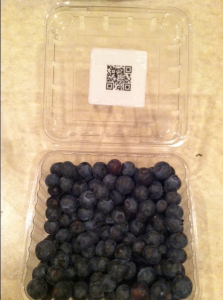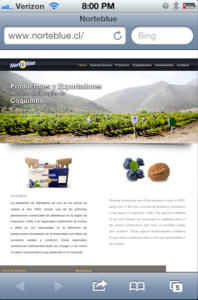Blueberries, QR Codes, and Product Packaging
Posted on by Timothy Boyle I bought some Norte Blue Chilean blue berries at my local grocery store the other day and when I got home and opened the container, to my surprise, starring back at me was a QR code. QR codes are popping up more and more on product packaging, though it remains rare on food packaging. Upon discovering this particular QR code I thought I might use it to illuminate the possibilities and also the mistakes of such usage.
I bought some Norte Blue Chilean blue berries at my local grocery store the other day and when I got home and opened the container, to my surprise, starring back at me was a QR code. QR codes are popping up more and more on product packaging, though it remains rare on food packaging. Upon discovering this particular QR code I thought I might use it to illuminate the possibilities and also the mistakes of such usage.
This particular QR code use I found interesting for a few reasons. First, I actually did a double take on this code, likely because at first I thought it was just a normal bar code of some sort, but after starring at it for a few moments I realized it was actually a QR code that I could scan. Second, it was underneath the lid, thus not visible to the shopping public. And third, once I scanned it I was a bit perplexed at the landing page.
When using QR codes on product packaging it can serve numerous purposes, often you might be using it to try and provide additional information about the product, and this information may or may not be used to help drive sales of the product in store. But you may also use the QR code to provide additional value or information to the consumer AFTER the purchase has already been made. So it is an appeal to the second use that I suspect Norte Blue was intending since it was under the lid and not on top of the lid for shoppers to see. This of course is a perfectly fine use of a QR code, as long as you are actually providing additional value to your consumer (though placing a QR code on the visible lid just seems like a more efficient use of the code no matter your intended purpose).
 This particular code unfortunately did a few things wrong. First, it contained no call to action, so no one will likely scan the code, even if they knew it was a QR code to be scanned. This almost completely negates the purpose of using a code on your product packaging. Second, the landing page is Norte Blue’s desktop website and thus not mobile optimized. This means more people will likely leave the page due to its difficult navigation. This is particularly bad if you intend to push sales from this landing page. Third, and likely a rare issue but specific to this case, Norte Blue’s website is in Spanish, so I have no idea what they even offer on their site. Know your consumer. If your consumer generally speaks English, make sure your landing page is in English.
This particular code unfortunately did a few things wrong. First, it contained no call to action, so no one will likely scan the code, even if they knew it was a QR code to be scanned. This almost completely negates the purpose of using a code on your product packaging. Second, the landing page is Norte Blue’s desktop website and thus not mobile optimized. This means more people will likely leave the page due to its difficult navigation. This is particularly bad if you intend to push sales from this landing page. Third, and likely a rare issue but specific to this case, Norte Blue’s website is in Spanish, so I have no idea what they even offer on their site. Know your consumer. If your consumer generally speaks English, make sure your landing page is in English.
Though Norte Blue may have not used QR codes very well in their first attempt, the possibilities are many for QR codes on food packaging.
Depending on the food we are discussing, you might use a QR code to provide possible recipes that use said ingredient you are selling; or perhaps you have a kid’s cereal or other kids food, you might have the QR code take the child to a fun game or app; or perhaps you want to try and promote online sales of your product, you might offer a lower price if they order directly from your QR code landing page, etc. Be creative and give the consumer something you actually suspect that might want, or find enjoyable.
A QR code can do many different things for your brand, your sales, or your customers, just make sure if you use them you use them properly and creatively. And please, please, make sure you use the language of choice when selling your product in a particular country. It works better when your consumer can understand you.

